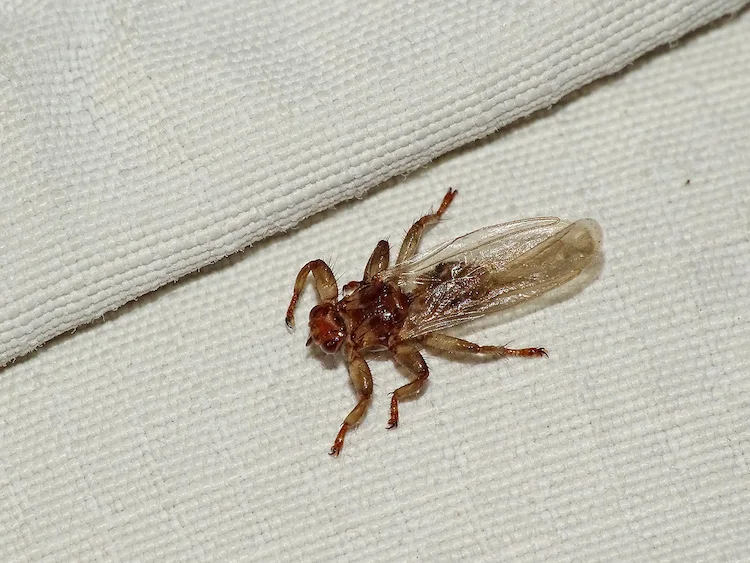Flying tick – this is what the deer lice fly (Liptotena cervi) is called. It belongs to the lice fly family and is a type of sting fly. They’re those pesky little bugs that fly straight at you in the woods, crawl into your hair, and bite your neck or head. How do you recognize flying ticks? Are the insects dangerous for humans and animals, where can you find them and how to get rid of them? Read on to learn all about the pleading insect.
What are flying ticks
The stag louse fly has a brown to black flat body, two long transparent wings and six feet. She is about half a centimeter tall. These insects sting animals and humans and are active in summer and autumn. The deer louse fly usually bites animals. The parasite bites and sucks the animal’s blood, just like regular ticks. The parasite stays on its host for about 20 minutes and bites hard several times.
In humans, the deer louse fly mostly bites in the neck area and on the head. Dogs are usually bitten on the anus, abdomen, and inner thighs. Most often, several parasites land on the host at the same time and bite it. The female stag louse lays the eggs on the host, and later the larvae fall to the ground and pupate.
Where to find ticks with wings
The insects live mainly on the edges of forests, but they can also be found on pastures. The stag louse fly is most active in late summer but can also be found as early as the early summer months. The adult animal seeks a host primarily through warmth.
How dangerous are deer lice flies for humans and animals
The flying tick transmits bacteria when it bites and thus brings diseases with it. It is the bacterium “Bartonella schoenbuchensis”, which causes inflammatory skin rashes as well as edema or suppuration in humans. It can also lead to elevated temperature and fever. The bite of the deer louse fly also causes purulent skin diseases in animals.
The bite sites can become severely inflamed. At first the bite may be barely noticeable, but within 3 days the bite site may develop into a hard, reddened wheal. The itching lasts 14 to 20 days.
Dermatitis caused by deer louse fly consists of small red papules, ranging in size from a few mm to 1-2 cm, mostly appearing on the scalp, neck and upper back. The papules usually appear 6-24 hours after the bite and they can persist for several weeks and in some people up to a year.
What are the symptoms of a bite
Some are allergic to the bites and need to be careful, but many just find them unbearably annoying. In general, the consequences of a bite can be as follows:
The bite site swells and hurts for several days. itching in the bite wound. Hematomas form on the affected area. Fever can occur. Skin rashes, wheals, edema, pustules and suppuration. Panic reactions, especially in animals, due to the pain.
What to do in case of a bite
How do you get rid of the flying tick? First, the bite site needs to be cooled, and then in the event of a bite, your best bet is to see a doctor – or, if your pet has been bitten, a veterinarian. Obligatory visit to the doctor in case of symptoms such as fever, rash or suppuration.
When your pet is bitten, you can easily remove the flying tick. Be careful and use a fine comb, such as a flea comb, to remove the parasite from your pet’s fur. An alternative is tape or a lint brush. A shower can also help. Always check your animals for ticks after the walk.
Effective means against flying bitches
Some people recommend camphor drops as a deer louse fly repellent, although this has not been scientifically proven. When you go for a walk, you can use mosquito net hats or jackets and wrap yourself up, but the malicious little creatures always somehow crawl through the protective clothing. And then it is even more difficult to remove them from the skin when they are under the mesh.
The formic acid can act as a repellent. Garlic can also be effective against flying ticks. Use antihistamines and resin cream in case you get bitten.
